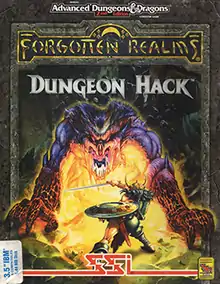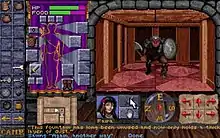Dungeon Hack
Dungeon Hack is a role-playing video game developed by DreamForge Intertainment and published by Strategic Simulations for DOS and NEC PC-9801 in 1993. The game is based in the Advanced Dungeons and Dragons world of Forgotten Realms.
| Dungeon Hack | |
|---|---|
 MS-DOS cover art | |
| Developer(s) | DreamForge Intertainment |
| Publisher(s) | Strategic Simulations |
| Designer(s) | Thomas J. Holmes Christopher L. Straka |
| Programmer(s) | Thomas J. Holmes |
| Composer(s) | Anthony Mollick |
| Platform(s) | DOS, NEC PC-9801 |
| Release | 1993 |
| Genre(s) | Role-playing video game |
| Mode(s) | Single player |
Gameplay

Dungeon Hack features a three-dimensional, randomly generated dungeon;[1][2] SSI claimed that "over 4 billion" different dungeons were possible.[3] The game features a pseudo-3D game screen based on Eye of the Beholder series. Like Rogue, dungeons are randomly generated whenever a new game is started. As a result, virtually no two dungeons generated by the game are identical. However, players can share "dungeon seed" codes that are generated by the game to play the same dungeons.
Dungeon Hack uses the rules mechanics of AD&D 2nd Edition. Permadeath—all saves are erased upon character death—is an option,[2] like traditional roguelike games but unlike other graphical AD&D games such as Pool of Radiance).
Plot
An adventurer (the player's character of choice) is sent by an evil[4] sorceress on a mission to find and retrieve a mysterious magical orb located within an ancient dungeon.
After defeating the final monster, the ending cinematic shows the adventurer leaves the dungeon with a wheelbarrow full of treasure, the sorceress waiting outside for him. The hero gives her the orb, and she gives him her thanks and says it time for them to leave. The hero remains behind during the credits to sort through his spoils. After the credits, the sorceress tells the hero to hurry as she is leaving and the adventure is over. The hero remarks on his treasure and that his adventure has only just begun, and moves his wheel barrel off screen dropping a coin, before quickly coming back and picks it back up and goes back off screen.
Reception
SSI sold 27,110 copies of Dungeon Hack.[7] Computer Gaming World's Scorpia in 1994 liked the game's flexibility and inclusion of all AD&D 2nd Edition character classes, and found that "a 10-15 level dungeon is probably the best". She concluded that "in spite of some weak points, Dungeon Hack delivers what it promises: the chance to create your own, specially-designed, hack-n-slash paradise".[2] The game got 3 out of 5 stars in Dragon.[5]
Dungeon Hack won Computer Game Review's "Most Replay Value of 1994" award. According to GameSpy's Allen Rausch, if "random creatures and meaningless hallways are your thing, you'll love Dungeon Hack -- the rest of us like at least a little story to justify our monster butchery."[8] Ian Williams of Paste rated the game #9 on his list of "The 10 Greatest Dungeons and Dragons Videogames" in 2015.[9]
References
- Tresca, Michael J. (2010), The Evolution of Fantasy Role-Playing Games, McFarland, p. 144, ISBN 978-0786458950
- Scorpia (February 1994). "Hackin' The Nights Away". Scorpion's View. pp. 62, 64. Cite magazine requires
|magazine=(help) - "Dungeon Hack". Computer Gaming World (advertisement). December 1993. p. 43. Retrieved 29 March 2016.
- PC Player issue 3 (February 1994), page 57.
- Petersen, Sandy (May 1994). "Eye of the Monitor". Dragon. No. 205. pp. 59–62.
- McCandless, David (February 1994). "PC Zone Review - Dungeon Hack". PC Zone. No. 11. Future plc. p. 90.
- Maher, Jimmy (2017-03-31). "Opening the Gold Box, Part 5: All That Glitters is Not Gold". The Digital Antiquarian.
- Rausch, Allen (2004-08-17). "A History of D&D Video Games - Part III". Game Spy. Retrieved November 17, 2012.
- "The 10 Greatest Dungeons and Dragons Videogames". pastemagazine.com. Retrieved 28 March 2018.
